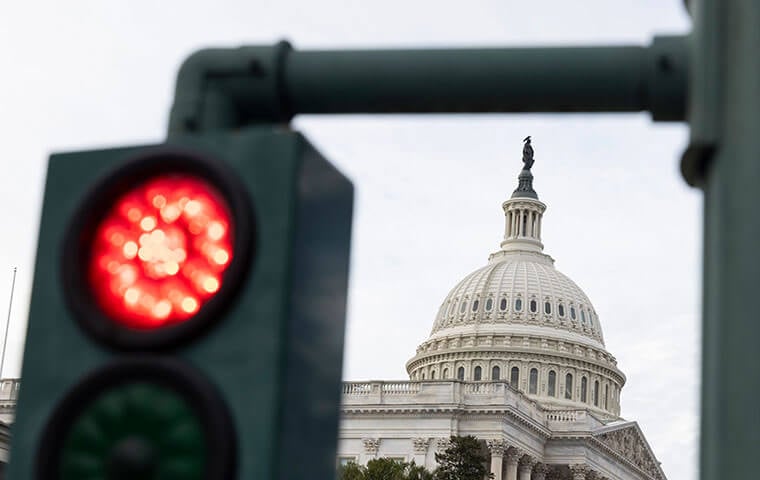 The US Capitol Building is seen on the eleventh day of the US federal government shutdown on October 11, 2025, in Washington, DC. Over 250,000 federal employees missed their paychecks this week due to the ongoing funding impasse. In the United States, government shutdowns occur when funding legislation required to finance the federal government is not enacted before the next fiscal year begins. Image: Aashish Kiphayet/ZUMA Press Wire/Shutterstock
By: FEDweek Staff
The US Capitol Building is seen on the eleventh day of the US federal government shutdown on October 11, 2025, in Washington, DC. Over 250,000 federal employees missed their paychecks this week due to the ongoing funding impasse. In the United States, government shutdowns occur when funding legislation required to finance the federal government is not enacted before the next fiscal year begins. Image: Aashish Kiphayet/ZUMA Press Wire/Shutterstock
By: FEDweek StaffA large share of the federal workforce stands to receive no pay in the pay distribution for the biweekly pay period ending Saturday (October 18) as there is little sign of the partial government shutdown ending by then.
Employees either working without pay or furloughed without pay should have received by now a reduced pay distributions for the pay period ending October 4—reflecting pay only through September 30, the last day of funding for fiscal year 2025. A pay distribution typically is made about a week after the end of a pay period, give or take several days on either side.
However, the entirety of the current October 5-October 18 period will fall within the shutdown period barring an unexpected development in Congress. Since approving a Republican version of a funding extension three weeks ago the House has remained out of session as a way of pressuring the Senate to accept that bill. The Senate in the meantime has voted repeatedly on both that measure and a Democratic alternative, with neither receiving the 60 votes needed for passage there.
Employees who are “exempt” from the furlough because their salaries are not paid out of annual appropriations should still be receiving full pay.
Also, some agencies kept employees on full pay for the period ending October 4 by drawing on special sources such as trust funds—including for example much of the IRS, the Smithsonian Institution and part of the EPA—but have since reached the end of that flexibility. Employees put in unpaid status during the current pay period should be receiving partial pay in their upcoming distribution.
Many employees have expressed concern about the impact on their benefits, particularly their health insurance coverage. OPM guidance says that enrollment in FEHB or other insurance “generally will not be affected if the employee is unable to make the required deductions for insurance and other benefits due to receiving a partial paycheck or no pay during a lapse of appropriations. The one exception is that if an employee is enrolled in a health care flexible spending account through FSAFEDS, they can’t be reimbursed for eligible health care claims until they return to pay status and payroll deductions can be made.”
Adding to the anxiety for many employees furloughed are the Trump administration’s suggestions that they will not be paid for that time retroactively once funding is restored—despite a 2019 law, signed by Trump in his first term. That law states that for “any lapse in appropriations that begins on or after December 22, 2018,” each employee furloughed as a result “shall be paid for the period of the lapse in appropriations . . . at the earliest date possible after the lapse in appropriations ends, regardless of scheduled pay dates.”
Prior to enactment of that law, employees kept at work unpaid were guaranteed back pay by law while those furloughed also received back pay for the time as a matter of practice.
The OPM guidance, updated in late September and not revised despite the administration’s later suggestions to the contrary, says “After the lapse in appropriations has ended, employees who were furloughed as the result of the lapse will receive retroactive pay for those furlough periods.”
Large Share of Federal Workforce about to Experience a Payless Pay Period
OPM Details Coverage Changes, Plan Dropouts for FEHB/PSHB in 2026
OMB Says Federal Workforce RIFs are Starting as Shutdown Drags On
Financial Impact of Shutdown Starts to Hit Home; WH Threatens No Back Pay
Surge of Retirement Applications Is in the Pipeline, Says OPM
See also,
TSP Takes Step toward Upcoming In-Plan Roth Conversions
5 Steps to Protect Your Federal Job During the Shutdown
Over 30K TSP Accounts Have Crossed the Million Mark in 2025
The Best Ages for Federal Employees to Retire

